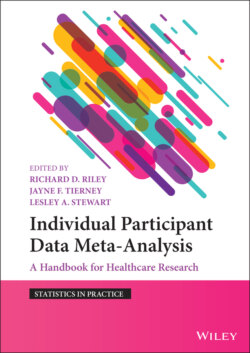Читать книгу Individual Participant Data Meta-Analysis - Группа авторов - Страница 22
2.5 Empirical Evidence of Differences Between Results of IPD and Aggregate Data Meta‐Analysis Projects
ОглавлениеThere are many empirical comparisons of results produced by IPD meta‐analyses with results based on corresponding analyses of published aggregate data. An early example, in advanced ovarian cancer, found that results based on published aggregate data suggest a 7.5% absolute improvement in the percentage of women surviving at 30 months with platinum‐based chemotherapy, whereas the IPD meta‐analysis suggests a 2.5% improvement in the percentage surviving.8 This disparity, which could have led to different clinical conclusions, seemed to be driven by the IPD meta‐analysis project including more trials, participants and follow‐up, as well as including all of the events in a time‐to‐event analysis, rather than calculating a risk ratio from events observed at a fixed time‐point.
In contrast, in a different example, there was no clear evidence of an effect of ovarian ablation on survival of women with early breast cancer, based on the published aggregate data, but a 10% absolute increase in the percentage surviving at 15 years based on IPD.62 In this case, the IPD for the included trials incorporated much greater follow‐up, leading to a near doubling of events. This, and a more appropriate time‐to‐event analysis, were likely to be the key drivers for the discrepancy with the aggregate data findings. Many other comparisons of results from IPD and aggregate data meta‐analysis projects have been carried out, not only in cancer and cardiovascular disease where IPD meta‐analysis first gained traction, but also in other healthcare areas such as infectious diseases, neurology, nephrology and critical care. The differences shown between IPD and aggregate data findings are variable and seem context specific (e.g. depending on the research question; Sections 2.2.1 and 2.6.1).63
A large systematic review that brought together published comparisons of treatment effects from IPD and aggregate data meta‐analyses found that many pairs of IPD and aggregate data analyses agreed in terms of the statistical significance of the overall results for the main outcomes. However, the disagreement observed in 20% of cases could have led to different clinical conclusions.63 The discrepancies did not seem to be clearly associated with variation in the number of trials, number of participants or length of follow‐up.63 Importantly, discrepancies are likely to be more pronounced when going beyond overall treatment effects, which is often a key aim of an IPD meta‐analysis project, such as when examining treatment‐covariate interactions at the participant level (Chapter 7).33
Evidence from a large cohort of systematic reviews of the effects of cancer therapies on survival showed that, on average, meta‐analysis results for the overall treatment effect derived from published aggregate data (based on hazard ratios) were slightly more in favour of the research treatment than those from IPD.47 Although most results were similar between aggregate data and IPD meta‐analyses, those discrepancies that did occur were often substantial.47 Importantly, results from aggregate data were most likely to agree with those from IPD when the number of participants or events (absolute information size) and the proportion of participants or events available from the aggregate data relative to the IPD (relative information size) were large. This emphasises that assessing the amount of information provided by the available aggregate data, and what the obtainable IPD might add for a particular research question, is an important step in determining when IPD will bring the greatest value (Section 2.6.3).
